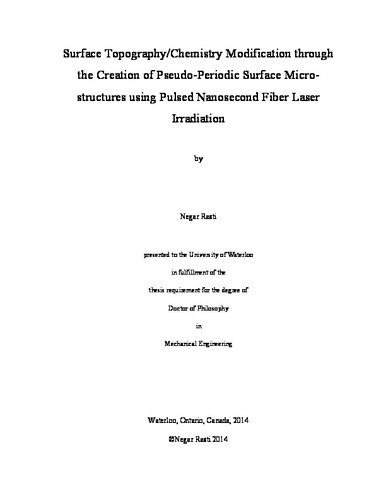| dc.description.abstract | The focus of this thesis is on the development of a methodology for modifying the surface of titanium implant devices to improve biocompatibility and osseointegration properties utilizing three approaches: 1) developing Pseudo-Periodic (PP) micro-structures on the surface of the implant to increase nano and micro roughness, 2) engraving parallel microgrooves on the surface of the implant, 3) modifying the chemistry of the substrate by increasing the oxide layer to augment the biocompatibility. A single-mode, inexpensive, pulsed nanosecond ytterbium fiber laser is used to modify pure titanium surfaces to improve surface topographical, chemical and mechanical properties, thereby improving surface biocompatibility properties.
The laser processing setup was designed to control different process parameters, including laser power, laser frequency, and scanning speed. The effect of each of these process parameters on the modified surface properties is then evaluated. The laser processing results in the formation of PP micro-structures, which protrude from the surface of the substrate and form nano and micro roughness on the laser path. Offsetting the laser beam in a desired space develops microgrooves.
The PP micro-structures are generated in two stages: 1) the initiation of structures, which occurs when the laser intensity is close to the threshold Intensity of the material (i.e., 1.27 MW/cm2 for titanium); and 2) the growth of the structures. The main factor in the growth of PP-based micro-structures is effective energy. The growth of the PP based micro-structures is observed through surface characterization techniques using scanning electron microscope (SEM) and profilometry analysis. The roughness of the micro-structures on titanium can increase to an average roughness of 1.7 μm. The size of the micro-structures can also increase to 30-50 μm, which is compatible with osteoblast (bone) cells and is, therefore, suitable for improving the biocompatibility properties of the implant’s surface.
The introduced laser processing technique simultaneously results in both surface chemical improvement and topographical improvement. The chemical properties of the modified surfaces are characterized using Energy-dispersive X-ray spectroscopy (EDAX) and X-ray Diffraction (XRD) analysis. The chemical characterization of the modified surfaces demonstrates the presence of the metastable anatase form of titania on surfaces developed at temperatures above 16500C. Anatase usually transforms to a rutile structure at temperatures higher than 700-10000C; therefore, this finding indicates that the introduced laser processing results in a solidification mechanism that does not take place in an equilibrium manner; as such, the resulting structures may not follow a conventional phase transformation diagram. The XRD characterization also demonstrates the transformation of αTi to βTi on the surface that forms above the Ti transus temperature, induced by laser processing using the introduced parameters. The increase in the hardness of the titanium is quantified through the nano-hardness characterization, which demonstrates a hardness increase from 5 to 35 MPa on the surfaces of the modified structures. The XRD results also show the presence of the rare structure of the titanium oxide, hongquiite, which has the same structure as TiC with high surface hardness.
To investigate the effect of the modified surfaces on the surface biocompatibility behaviour, MG 63 cells are cultured on the six selected surface categories for time durations of: 10 hours, 1 day, and 3 days. These time periods permit the observation of the first stages of bone integration, including cell attachment, cell adhesion and cell viability, which are the essential cell characteristics for a successful cell proliferation. Cell behaviour on each substrate is analyzed using three different characterization techniques; (i) Statistical analysis based on SEM images using ImageJ software to characterize and quantify cell morphology, area, density, and orientation; (ii) Trypsinization analysis for quantifying cell adhesion strength; and (iii) Cell metabolic activity characterization on different substrates, which is quantified by analyzing cell viability using alamar blue.
The results demonstrate an increase of cell orientation on the modified surfaces up to four times,, compared to the unmodified surfaces. The trypsinization analysis of the surfaces shows an increase in cell adhesion strength of the PP based rough and grooved surfaces for 4 to 4.9 times compare to the unmodified surfaces. The results from the alamar blue test demonstrated an increase in cell viability up to eleven times greater than cell viability on polished surfaces. | en |

